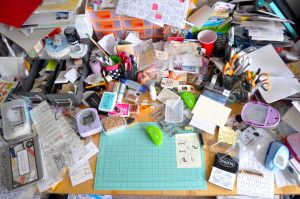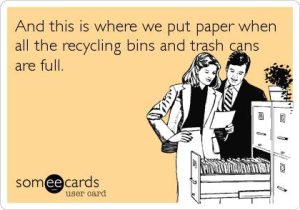A few months ago, I discovered K.C. Davis, a licensed counselor, and the creator of the mental health care platform, Struggle Care. I found her podcasts about how to handle home tasks and self-care issues to be enjoyable, approachable, and non-judgmental. I’ve recommended them over and over to clients, and particularly enjoyed her book, How to Keep House While Drowning. It’s a humorous, practical, down-to-earth, and super non-judgmental book full of do-able tips for staying on top of those tasks that can seem so insurmountable, but that really need to get done – eventually, and in your own way, depending upon your energy level and motivation.
What I love most about Davis’s book is her quick and fairly easy method for cleaning out and organizing a messy room. She calls it “The Five Things Tidying Method”:

- Collect trash
- Collect dirty dishes
- Collect laundry
- Gather together things that have a home (a regular, designated place) in the room
- Gather together things that don’t have a home in the room
In her book, she gives specifics on how to handle each step. To find out more, I recommend you check out her book (for that and other seriously helpful tips!)
As I pondered her simple and easy to implement system, I realized that most of the cluttered, messy and disorganized offices (home or business) that I’ve helped organize can be at least minimally cleared using a similar system:
- Collect trash
- Gather together paperwork that needs action
- Gather together paperwork & supplies that don’t need action but need to be saved AND that already have a home in your office
- Gather together paperwork & supplies to save that don’t need action but that DON’T already have a home in your office
- Gather together things that don’t belong in the office at all
These steps are intended just to be a MAJOR, down and dirty, macro-sorting time, not a hard decision-making, time-consuming, detailed process. If you’re struggling to decide if the item or paper is something you need to keep or can toss, just keep it for now. You can decide later. Depending upon how cluttered your office is, this may only take one session, but if you have limited energy, motivation, or time, you can tackle it in smaller, more manageable sessions. If all you do is the first two steps, you’ll have gone a long way towards clearing your space and gaining control of what you need to deal with in the short term.
Specific tips for your BIG SORT:
(I suggest putting on some motivating music to help get you going!)
- Collect trash
Grab a trash bag and/or recycling bin. Trash is anything that isn’t relevant any

more, like flyers, brochures, coupons, outdated paperwork, dried-out or used-up office supplies, etc. Set up a separate bag or box for things that need to be shredded – any papers that have financial or medical information (put a sticky note on it that says “SHRED”, so it doesn’t get mixed up in trash or recycling – paper grocery bags are perfect for this.) This will cut down on a ton of clutter that tends to build up, particularly in home office spaces. If you don’t own a shredder, get one! Really. Identity theft is real, and devastating! But if you’ve accumulated a ton of stuff that needs to be shredded, grab a bunch of bags or boxes to collect it in and take it to Staples, UPS store, or similar place to be shredded. It’s TOTALLY worth the minimal amount you’ll pay per pound to get a huge load done in one fell swoop. It will save you valuable time that you can spend on something more productive and meaningful. When you have your own shredder, you can then keep up with small amounts as it accumulates on your own after you get rid of the initial big pile. Sometimes, just getting all the trash out of your space can make a huge difference!
- Paperwork that needs action
In this initial sweep, don’t take time to set up any elaborate system. Just find a paper tray, bin, box, or basket, label it “Action” with a sticky note, and throw anything in there that needs action. You can sort it another time and set up something more efficient later. At least this way, you’ll know where to find it rather than having it scattered in piles all over your workspace.
- Paperwork and supplies that don’t need action, but need to be saved AND already have a home in your office
 Gather the paperwork into one box or bin and supplies in another. Label the paperwork box “To File”, and the supply box “Supplies to Put Away.” Don’t worry about getting this stuff into homes right now. That’s for the next session, when you can take time to file, and stash supplies away in your desk or supply closet.
Gather the paperwork into one box or bin and supplies in another. Label the paperwork box “To File”, and the supply box “Supplies to Put Away.” Don’t worry about getting this stuff into homes right now. That’s for the next session, when you can take time to file, and stash supplies away in your desk or supply closet.
- Paperwork and supplies that don’t need action, but need to be saved and DON’T already have a home in your office
Again, grab another box for paperwork and one for supplies. Label them “Needs a Home.” You can decide where those will go in another organizing session, whether it’s in a file, a desk drawer, or a supply closet.
- Things that don’t belong in the office at all
This is usually more of a problem in a home office, but can show up in your business office, too. Gather anything that belongs somewhere else, either elsewhere in your home, in the file or supply room at work, or in someone else’s space. DON’T take the time to run around and put everything away as you find it. That’s too time consuming and can distract and derail you from your goal – a quick, down and dirty, MAJOR sort! Mark this box “Elsewhere” and take the time AFTER you’re done with your big sort to put things away in your home later, drop it off in someone else’s office, or carry it all home and away from your business office space.
WHAT YOU’LL NEED TO DO YOUR BIG SORT:
Sticky notes
Marker
Trash bag(s)
Recycling bin(s) or bag(s)
Boxes, bins or paper grocery bags for:
“Shred”
“Action”
“To File”
“Supplies to Put Away”
“Needs a home – paper”
“Needs a home – supplies”
“Elsewhere”
Banker’s boxes are great for this stuff – and can be collapsed and used over and over. But any boxes, bins, baskets, paper grocery bags, laundry baskets, etc. will do.
The point of doing a macro-sort like this is to clear your space as quickly and painlessly as possible. This is not the time for setting up systems to manage your stuff in the future. It’s simply the first step of many to come. Stay tuned for more detailed upcoming blogs on how to set up systems for steps 2, 3 and 4. Hopefully, this will give you some breathing space to live and work. It will give you that “major accomplishment” feeling, and help you to feel more in control as you move on to a better organized and more efficient workspace!


